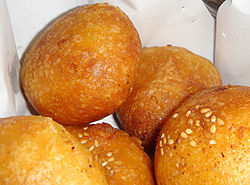Bánh rán
This article needs additional citations for verification. (March 2017) |
This article includes a list of references, related reading or external links, but its sources remain unclear because it lacks inline citations. (November 2018) |
 A container of bánh rán, just out of the hot cooking oil. | |
| Type | Deep-fried glutinous rice ball |
|---|---|
| Course | Tea, Snack |
| Place of origin | Vietnam |
| Region or state | North Vietnam |
Bánh rán is a deep-fried glutinous rice ball Vietnamese dish from northern Vietnam. In Vietnamese, bánh is a category of food including cakes, pies, and pastries, while rán means "fried."
Its outer shell is made from glutinous rice flour, and covered all over with white sesame seeds. Its filling is made from sweetened mung bean paste, and scented with jasmine flower essence. Traditionally, the filling should be separated from the shell so that if one shakes the bánh rán, one can feel the filling rattle against the inside of the shell.
In southern Vietnam, a similar dish, called bánh cam, is nearly identical to bánh rán, but does not contain jasmine essence. A further difference is that for bánh cam the filling does not need to be separated from the shell. In Southern Vietnam, bánh cam is different from bánh rán as the Northern version is traditionally eaten with a sugary syrup that is poured over the pastry.
The Northern "bánh rán" usually consists of: minced pork, wood-ear mushroom, dry vermicelli, carrot, salt and pepper. This mixture then blend with raw egg to create a soft, salty filling. It usually serves with sweet and sour chili sauce with sliced radish/papaya.
Bánh rán is also the Vietnamese translation of the Japanese confection dorayaki, made famous internationally by the manga Doraemon.
See also[]
References[]
- Jacqueline Pham (18 July 2013). Banh Mi: 75 Banh Mi Recipes for Authentic and Delicious Vietnamese Sandwiches Including Lemongrass Tofu, Soy Ginger Quail, Sugarcane Shrimp Cake, and Honey-Glazed Beef. Adams Media. p. 20. ISBN 978-1-4405-5077-5.
External links[]
| Wikimedia Commons has media related to Bánh rán. |
- Vietnamese pastries
- Vietnamese words and phrases
- Deep fried foods
- Stuffed desserts
- Bánh